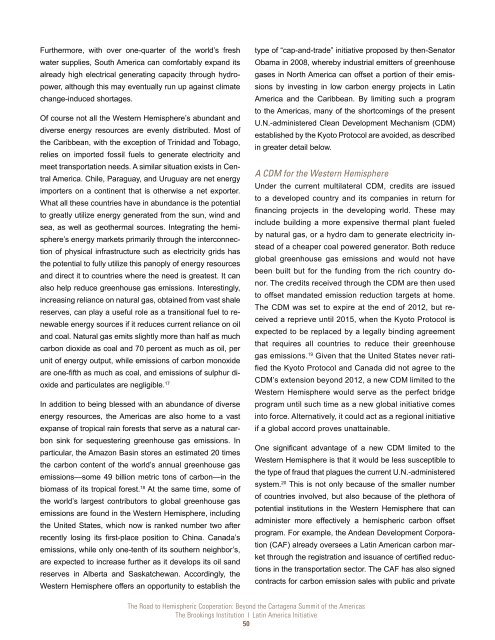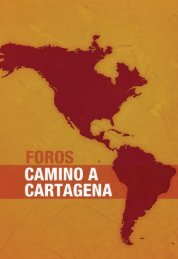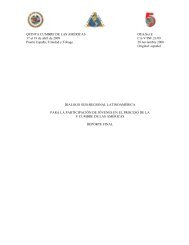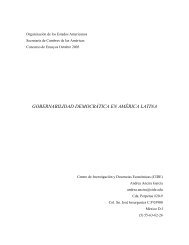The Road to Hemispheric Cooperation: Beyond the Cartagena
The Road to Hemispheric Cooperation: Beyond the Cartagena
The Road to Hemispheric Cooperation: Beyond the Cartagena
Create successful ePaper yourself
Turn your PDF publications into a flip-book with our unique Google optimized e-Paper software.
Fur<strong>the</strong>rmore, with over one-quarter of <strong>the</strong> world’s fresh<br />
water supplies, South America can comfortably expand its<br />
already high electrical generating capacity through hydropower,<br />
although this may eventually run up against climate<br />
change-induced shortages.<br />
Of course not all <strong>the</strong> Western Hemisphere’s abundant and<br />
diverse energy resources are evenly distributed. Most of<br />
<strong>the</strong> Caribbean, with <strong>the</strong> exception of Trinidad and Tobago,<br />
relies on imported fossil fuels <strong>to</strong> generate electricity and<br />
meet transportation needs. A similar situation exists in Central<br />
America. Chile, Paraguay, and Uruguay are net energy<br />
importers on a continent that is o<strong>the</strong>rwise a net exporter.<br />
What all <strong>the</strong>se countries have in abundance is <strong>the</strong> potential<br />
<strong>to</strong> greatly utilize energy generated from <strong>the</strong> sun, wind and<br />
sea, as well as geo<strong>the</strong>rmal sources. Integrating <strong>the</strong> hemisphere’s<br />
energy markets primarily through <strong>the</strong> interconnection<br />
of physical infrastructure such as electricity grids has<br />
<strong>the</strong> potential <strong>to</strong> fully utilize this panoply of energy resources<br />
and direct it <strong>to</strong> countries where <strong>the</strong> need is greatest. It can<br />
also help reduce greenhouse gas emissions. Interestingly,<br />
increasing reliance on natural gas, obtained from vast shale<br />
reserves, can play a useful role as a transitional fuel <strong>to</strong> renewable<br />
energy sources if it reduces current reliance on oil<br />
and coal. Natural gas emits slightly more than half as much<br />
carbon dioxide as coal and 70 percent as much as oil, per<br />
unit of energy output, while emissions of carbon monoxide<br />
are one-fifth as much as coal, and emissions of sulphur dioxide<br />
and particulates are negligible. 17<br />
In addition <strong>to</strong> being blessed with an abundance of diverse<br />
energy resources, <strong>the</strong> Americas are also home <strong>to</strong> a vast<br />
expanse of tropical rain forests that serve as a natural carbon<br />
sink for sequestering greenhouse gas emissions. In<br />
particular, <strong>the</strong> Amazon Basin s<strong>to</strong>res an estimated 20 times<br />
<strong>the</strong> carbon content of <strong>the</strong> world’s annual greenhouse gas<br />
emissions—some 49 billion metric <strong>to</strong>ns of carbon—in <strong>the</strong><br />
biomass of its tropical forest. 18 At <strong>the</strong> same time, some of<br />
<strong>the</strong> world’s largest contribu<strong>to</strong>rs <strong>to</strong> global greenhouse gas<br />
emissions are found in <strong>the</strong> Western Hemisphere, including<br />
<strong>the</strong> United States, which now is ranked number two after<br />
recently losing its first-place position <strong>to</strong> China. Canada’s<br />
emissions, while only one-tenth of its sou<strong>the</strong>rn neighbor’s,<br />
are expected <strong>to</strong> increase fur<strong>the</strong>r as it develops its oil sand<br />
reserves in Alberta and Saskatchewan. Accordingly, <strong>the</strong><br />
Western Hemisphere offers an opportunity <strong>to</strong> establish <strong>the</strong><br />
type of “cap-and-trade” initiative proposed by <strong>the</strong>n-Sena<strong>to</strong>r<br />
Obama in 2008, whereby industrial emitters of greenhouse<br />
gases in North America can offset a portion of <strong>the</strong>ir emissions<br />
by investing in low carbon energy projects in Latin<br />
America and <strong>the</strong> Caribbean. By limiting such a program<br />
<strong>to</strong> <strong>the</strong> Americas, many of <strong>the</strong> shortcomings of <strong>the</strong> present<br />
U.N.-administered Clean Development Mechanism (CDM)<br />
established by <strong>the</strong> Kyo<strong>to</strong> Pro<strong>to</strong>col are avoided, as described<br />
in greater detail below.<br />
A CDM for <strong>the</strong> Western Hemisphere<br />
Under <strong>the</strong> current multilateral CDM, credits are issued<br />
<strong>to</strong> a developed country and its companies in return for<br />
financing projects in <strong>the</strong> developing world. <strong>The</strong>se may<br />
include building a more expensive <strong>the</strong>rmal plant fueled<br />
by natural gas, or a hydro dam <strong>to</strong> generate electricity instead<br />
of a cheaper coal powered genera<strong>to</strong>r. Both reduce<br />
global greenhouse gas emissions and would not have<br />
been built but for <strong>the</strong> funding from <strong>the</strong> rich country donor.<br />
<strong>The</strong> credits received through <strong>the</strong> CDM are <strong>the</strong>n used<br />
<strong>to</strong> offset mandated emission reduction targets at home.<br />
<strong>The</strong> CDM was set <strong>to</strong> expire at <strong>the</strong> end of 2012, but received<br />
a reprieve until 2015, when <strong>the</strong> Kyo<strong>to</strong> Pro<strong>to</strong>col is<br />
expected <strong>to</strong> be replaced by a legally binding agreement<br />
that requires all countries <strong>to</strong> reduce <strong>the</strong>ir greenhouse<br />
gas emissions. 19 Given that <strong>the</strong> United States never ratified<br />
<strong>the</strong> Kyo<strong>to</strong> Pro<strong>to</strong>col and Canada did not agree <strong>to</strong> <strong>the</strong><br />
CDM’s extension beyond 2012, a new CDM limited <strong>to</strong> <strong>the</strong><br />
Western Hemisphere would serve as <strong>the</strong> perfect bridge<br />
program until such time as a new global initiative comes<br />
in<strong>to</strong> force. Alternatively, it could act as a regional initiative<br />
if a global accord proves unattainable.<br />
One significant advantage of a new CDM limited <strong>to</strong> <strong>the</strong><br />
Western Hemisphere is that it would be less susceptible <strong>to</strong><br />
<strong>the</strong> type of fraud that plagues <strong>the</strong> current U.N.-administered<br />
system. 20 This is not only because of <strong>the</strong> smaller number<br />
of countries involved, but also because of <strong>the</strong> plethora of<br />
potential institutions in <strong>the</strong> Western Hemisphere that can<br />
administer more effectively a hemispheric carbon offset<br />
program. For example, <strong>the</strong> Andean Development Corporation<br />
(CAF) already oversees a Latin American carbon market<br />
through <strong>the</strong> registration and issuance of certified reductions<br />
in <strong>the</strong> transportation sec<strong>to</strong>r. <strong>The</strong> CAF has also signed<br />
contracts for carbon emission sales with public and private<br />
<strong>The</strong> <strong>Road</strong> <strong>to</strong> <strong>Hemispheric</strong> <strong>Cooperation</strong>: <strong>Beyond</strong> <strong>the</strong> <strong>Cartagena</strong> Summit of <strong>the</strong> Americas<br />
<strong>The</strong> Brookings Institution ❘ Latin America Initiative<br />
50








